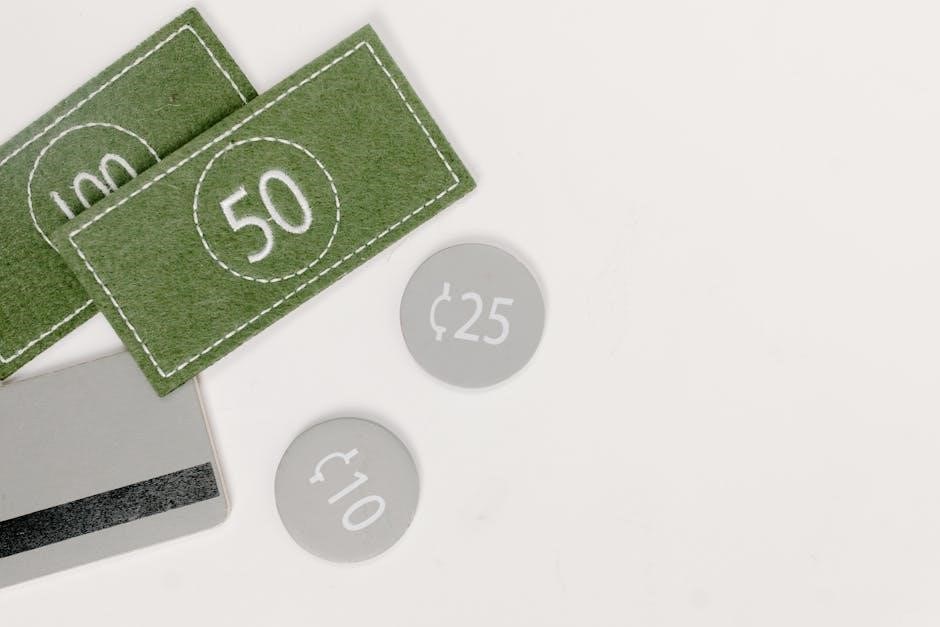Credit cards are essential tools for teaching financial responsibility. They help students understand spending‚ budgeting‚ and credit management. Worksheets simplify complex concepts‚ making learning interactive and effective.
1.1 Understanding the Basics of Credit Cards
Credit cards allow users to borrow money for purchases‚ with repayment due monthly. Key concepts include credit limits‚ APR (Annual Percentage Rate)‚ and credit scores. Worksheets help students grasp how interest accrues‚ fees apply‚ and responsible usage impacts credit history. By simulating real scenarios‚ these tools teach budgeting‚ spending habits‚ and long-term financial consequences. Understanding these basics is crucial for making informed decisions and avoiding debt. Worksheets provide a hands-on approach to mastering credit card fundamentals‚ ensuring students are prepared for financial independence.
1.2 Why Financial Literacy Matters for Students
Financial literacy is essential for students to navigate the complexities of money management‚ enabling them to make informed decisions about earning‚ saving‚ and spending. It equips students with skills to budget effectively‚ avoid debt‚ and understand credit card usage. By mastering financial concepts early‚ students can build a strong foundation for long-term stability. Credit card worksheets serve as practical tools‚ helping students grasp real-world scenarios and develop healthy habits. This knowledge empowers them to manage finances confidently and avoid costly mistakes.

Key Concepts Related to Credit Cards
Understanding credit card concepts like credit limit‚ APR‚ interest‚ and credit score is crucial. These elements help students manage spending‚ avoid debt‚ and build financial stability through responsible habits.
2.1 What is a Credit Limit and How Does It Work?
A credit limit is the maximum amount you can charge on your credit card. It’s set by the issuer based on your income‚ credit history‚ and other factors. Exceeding your limit can result in fees or reduced credit score. Staying within your limit helps maintain financial health and builds positive credit habits. Understanding and managing your credit limit is essential for responsible card usage and long-term financial stability.
2.2 Annual Percentage Rate (APR): What You Need to Know
The Annual Percentage Rate (APR) is the interest rate charged on unpaid credit card balances. It’s expressed as a yearly rate and can vary based on your creditworthiness. If you don’t pay your balance in full each month‚ APR determines the interest added to your debt. Understanding APR helps you avoid high interest charges and manage your spending wisely. A lower APR means less interest over time‚ while a higher APR increases borrowing costs. Always review the APR before applying for a credit card to make informed financial decisions.
2.3 Credit Score: Its Impact on Your Financial Future
Your credit score plays a crucial role in shaping your financial future. It reflects your credit history and payment behavior‚ influencing loan approvals‚ interest rates‚ and even apartment rentals. A good credit score can help you secure better loan terms and lower deposits. For students‚ building a strong credit score early can open doors to financial opportunities. Monitoring and maintaining a healthy credit score is essential for long-term financial stability and independence. Understanding how credit card usage affects your score is a key part of financial literacy.

Credit Card Worksheets for Students
Credit card worksheets are interactive tools designed to help students understand credit card usage‚ budgeting‚ and financial management through practical exercises and real-life scenarios.
3.1 What is a Credit Card Worksheet?
A credit card worksheet is an educational tool designed to help students understand credit card concepts‚ such as budgeting‚ interest calculations‚ and payment strategies. It typically includes exercises‚ tables‚ and sample questions to promote hands-on learning. These worksheets often cover topics like credit limits‚ APR‚ and credit scores‚ making complex financial ideas accessible. They are widely used in classrooms‚ workshops‚ or self-study to encourage financial literacy and responsible credit card use. Many worksheets are available as downloadable PDFs‚ offering structured activities for practical learning experiences.
3.2 How Worksheets Help Students Understand Credit Card Usage
Credit card worksheets are designed to simplify complex financial concepts‚ making them easier for students to understand. By providing structured exercises‚ they help students practice budgeting‚ calculating interest‚ and managing payments. These tools also encourage critical thinking through real-life scenarios‚ such as comparing credit card offers or understanding fees. Interactive activities reinforce key lessons‚ ensuring students grasp how credit cards work before making real-world decisions. This hands-on approach fosters financial literacy and prepares students for responsible credit card usage.
3.3 Benefits of Using Worksheets for Financial Education
Worksheets provide an interactive and structured way for students to grasp financial concepts. They offer clarity on complex topics like credit card interest and fees‚ making learning more engaging. By breaking down information into manageable exercises‚ worksheets help students track spending and payment habits. They also promote personalized learning‚ allowing students to apply concepts to their own lives. Regular use of worksheets fosters better financial decision-making skills and builds confidence in managing money effectively. This practical approach ensures long-term financial literacy and responsibility.

Structure of a Credit Card Worksheet
A credit card worksheet typically includes tables‚ columns‚ and sections for tracking purchases‚ balances‚ interest rates‚ and payment details to help students understand and manage credit card usage effectively.
4.1 Breaking Down the Components of a Worksheet
A credit card worksheet for students typically includes sections for purchase details‚ current balance‚ interest rates‚ payment amounts‚ and due dates. It may also feature columns for tracking interest charges‚ fees‚ and remaining balances. Some worksheets include space for calculating minimum payments and total interest paid over time. The structure is designed to be simple and organized‚ helping students understand how credit card balances accumulate and how payments impact debt. The components are arranged to promote clarity and ease of use‚ making financial concepts more accessible for learners.
4.2 Sample Questions and Exercises for Learning
Credit card worksheets often include sample questions and exercises to help students apply concepts. For example‚ a question might ask‚ “If you charge $500 at 18% APR‚ how much interest will you pay in a year?” Exercises may involve calculating minimum payments or comparing different payment strategies. These activities encourage critical thinking and practical application‚ making financial concepts more relatable. They also help students understand the long-term effects of credit card use and promote responsible habits. Such tools are essential for hands-on learning and financial literacy development.
4.3 How to Effectively Use Worksheets in the Classroom
To effectively use credit card worksheets in the classroom‚ teachers should begin by introducing the material with clear instructions. Ensure students understand the objectives and tasks. Step-by-step guidance helps students grasp complex concepts like APR and credit limits. Encourage collaborative learning by pairing students to discuss and solve problems together. Incorporate real-world scenarios to make exercises relatable. Provide immediate feedback by reviewing answers as a class. This approach fosters engagement‚ understanding‚ and practical application of financial literacy. It also helps students connect theory with real-life situations‚ enhancing their learning experience.

Importance of Credit Card Education for Students
Teaching students about credit cards fosters financial literacy‚ independence‚ and responsible spending habits. It helps them avoid debt and build a strong foundation for future financial stability.
5.1 Avoiding Debt: Lessons from Credit Card Worksheets
Credit card worksheets teach students how to avoid debt by understanding interest rates‚ fees‚ and the importance of paying more than the minimum. They learn to budget‚ track expenses‚ and prioritize payments. These tools emphasize the consequences of overspending and the benefits of timely payments. By practicing with real-world scenarios‚ students develop strategies to manage credit responsibly and avoid financial pitfalls. This hands-on learning fosters disciplined spending habits and empowers them to maintain financial stability.
5.2 Building Healthy Financial Habits Early
Credit card worksheets help students establish healthy financial habits by teaching budgeting‚ saving‚ and smart spending. They learn to prioritize needs over wants and understand the long-term effects of financial decisions. By tracking expenses and setting financial goals‚ students develop discipline and responsibility. These habits reduce the risk of overspending and promote a savings mindset. Early adoption of these practices ensures a strong foundation for managing money effectively and achieving long-term financial security and stability.

5.3 Empowering Students to Make Smart Financial Decisions
Credit card worksheets empower students by equipping them with essential knowledge to make informed financial choices. Through interactive exercises‚ they learn to evaluate spending habits‚ understand interest rates‚ and avoid unnecessary debt. These tools foster critical thinking and problem-solving skills‚ enabling students to prioritize their financial goals. By mastering these concepts early‚ students gain confidence in managing their finances responsibly and making decisions that align with their long-term objectives. This empowerment sets them up for a secure and independent financial future.

Managing Credit Card Debt
Learn effective strategies to manage credit card debt‚ including paying more than the minimum‚ understanding interest rates‚ and avoiding unnecessary purchases to stay financially stable.
6.1 Understanding Interest Charges and Fees
Understanding interest charges and fees is crucial for managing credit card debt effectively. Interest is charged when you don’t pay your balance in full each month‚ and it can accumulate quickly‚ increasing your debt. Additionally‚ credit cards come with various fees such as late payment fees‚ annual fees‚ and foreign transaction fees. These charges can add up‚ making it harder to pay off your debt. It’s essential for students to be aware of these costs to avoid unnecessary expenses and maintain good financial health. Always review your credit card terms to understand the interest rates and fees applicable to your account.
6.2 Strategies for Paying Off Credit Card Debt
To effectively pay off credit card debt‚ start by assessing your financial situation. List all your credit cards‚ including balances‚ interest rates‚ and minimum payments. Consider strategies like the debt avalanche method‚ which prioritizes high-interest debt‚ or the debt snowball method‚ which targets smaller balances first. Paying more than the minimum payment can accelerate debt repayment. Communicate with your credit card company to potentially lower interest rates or waive fees. Explore balance transfer options or debt consolidation loans with lower interest rates. Create a budget to allocate extra funds towards debt repayment and avoid unnecessary expenses. Consider the 50/30/20 rule to manage income allocation. Use budgeting apps or spreadsheets to track payments and stay organized. Automating payments can help ensure timely payments. Stay disciplined and adjust your strategy as needed to stay on track. Learning from this experience will help avoid future debt.
6.3 The Impact of Minimum Payments on Debt
Making only minimum payments on credit card debt can significantly prolong the repayment period. Most of the payment goes toward interest rather than the principal‚ leading to slower debt reduction. This results in paying more in interest over time. For example‚ a $1‚000 balance with a 20% APR could take over 10 years to pay off with minimum payments. This highlights the importance of paying more than the minimum to reduce debt faster and avoid long-term financial strain.

Building Credit with a Credit Card
Using a credit card responsibly helps students establish a positive credit history. Timely payments and low credit utilization demonstrate financial responsibility‚ boosting credit scores over time.
7.1 How Credit Card Usage Affects Your Credit Score
Credit card usage significantly impacts your credit score through factors like payment history‚ credit utilization‚ and credit history length. Timely payments and low balances demonstrate responsibility‚ boosting your score. High credit utilization can lower it. Avoiding new credit inquiries and maintaining a mix of credit types also supports a healthy score. Responsible use helps build a strong credit foundation.
7.2 Tips for Maintaining a Good Credit History
To maintain a good credit history‚ pay bills on time‚ keep credit utilization below 30%‚ and monitor your credit report regularly. Avoid applying for multiple credit cards in a short period‚ as this can harm your score. Build a long credit history and avoid closing old accounts‚ as this affects your credit age. Consistent responsible behavior ensures a strong credit profile.
7.3 The Role of Credit Cards in Establishing Credit
Credit cards play a crucial role in establishing credit‚ especially for students. Using a credit card responsibly helps build a positive payment history‚ which is essential for a strong credit score. By making regular‚ on-time payments and keeping credit utilization low‚ students can demonstrate financial responsibility. A credit card also provides an opportunity to start building credit from an early age‚ which is beneficial for future loans and financial endeavors. Consistent‚ responsible use ensures a solid foundation for long-term financial health.

Practical Activities for Students
Engage students with interactive exercises‚ real-world case studies‚ and group discussions to apply credit card knowledge practically. These activities enhance understanding and retention of financial concepts effectively.
8.1 Case Studies: Real-World Scenarios for Learning
Case studies provide students with real-life scenarios to explore credit card usage. Worksheets include examples like managing purchases‚ avoiding overspending‚ and dealing with debt. These exercises help students analyze decisions‚ calculate interest‚ and plan payments. By solving these scenarios‚ students develop practical problem-solving skills and understand the consequences of financial choices. This hands-on approach makes learning relatable and prepares them for real-world credit card management‚ fostering financial responsibility and smart decision-making early on.
8.2 Interactive Exercises to Reinforce Concepts
Interactive exercises in credit card worksheets engage students through practical tasks. These include quizzes‚ budget calculators‚ and simulations of credit card usage. Students practice calculating interest‚ comparing payment plans‚ and allocating income wisely. Such exercises make abstract concepts tangible‚ encouraging active learning. They also foster collaboration when completed in groups‚ sparking discussions about financial strategies. These tools enhance retention and provide immediate feedback‚ helping students grasp credit card management confidently and effectively.
8.3 Group Discussions to Share Knowledge and Experiences
Group discussions are a powerful way to deepen students’ understanding of credit card concepts. By sharing insights and personal experiences‚ students gain diverse perspectives on managing credit responsibly. These discussions encourage collaboration and critical thinking‚ allowing peers to learn from one another. Teachers can guide conversations to address common misconceptions and reinforce key lessons from worksheets. This interactive approach fosters a supportive environment where students feel comfortable asking questions and exploring real-world financial scenarios together.

Additional Resources for Learning
Explore recommended websites‚ video tutorials‚ and mobile apps that offer practical guides and tools for understanding credit card management and budgeting effectively.
9.1 Recommended Websites for Credit Card Education
Several websites offer valuable resources for credit card education‚ including NerdWallet‚ CreditCards.com‚ and Khan Academy. These platforms provide detailed guides‚ calculators‚ and interactive tools to help students understand credit card usage. Additionally‚ sites like ConsumerFinance.gov offer free educational materials‚ including PDF worksheets‚ to teach financial literacy. These resources are tailored to help students manage credit responsibly‚ avoid debt‚ and build a strong financial foundation. They are accessible‚ user-friendly‚ and perfect for both classroom and self-paced learning.
9.2 Video Lessons and Tutorials on Credit Card Usage
Video lessons are an engaging way for students to learn about credit card usage. Platforms like YouTube offer tutorials from trusted sources such as Khan Academy and CreditCards.com. These videos explain concepts like interest calculations‚ debt avoidance‚ and credit score impact. They also provide practical tips on choosing the right card and understanding statements. Many tutorials are designed for beginners‚ making complex topics easy to grasp. These resources are free‚ accessible‚ and ideal for visual learners seeking to enhance their financial literacy through dynamic content.
9.3 Mobile Apps for Tracking Credit and Budgeting
Mobile apps like Mint‚ YNAB (You Need A Budget)‚ and Credit Karma simplify credit and budget tracking. These apps allow users to monitor spending‚ set budgets‚ and track credit scores in real-time. They also provide alerts for suspicious activity and offer tips to improve financial health. Many apps are free and user-friendly‚ making them ideal for students to manage their finances effectively. By integrating these tools‚ students can develop better money management habits and stay on top of their credit card usage effortlessly.
Mastery of credit card concepts through worksheets empowers students with financial literacy‚ fostering responsible credit card use and a secure financial future from an early age.
10.1 Summarizing Key Takeaways from the Worksheet
The worksheet provides a clear understanding of credit card fundamentals‚ emphasizing responsible usage‚ budgeting‚ and debt management. It highlights the importance of credit scores‚ APR‚ and credit limits. By analyzing real-world scenarios‚ students learn to avoid financial pitfalls and make informed decisions. The practical exercises reinforce the consequences of overspending and the benefits of timely payments. This comprehensive approach equips students with essential skills to navigate credit card usage wisely‚ fostering long-term financial stability and independence.
10.2 Encouraging Continuous Learning and Financial Awareness
Continuous learning is essential for maintaining financial awareness‚ especially for students. The worksheet serves as a foundation‚ but further exploration is key. Encourage students to seek additional resources‚ such as financial blogs or educational videos‚ to deepen their understanding. Regular discussions and practical exercises can reinforce concepts and promote long-term financial literacy. By fostering a habit of learning‚ students can develop the confidence and skills needed to manage their finances effectively and make informed decisions throughout their lives.
